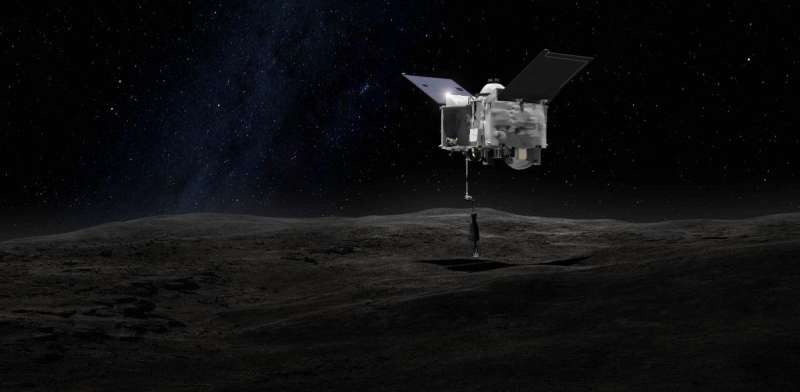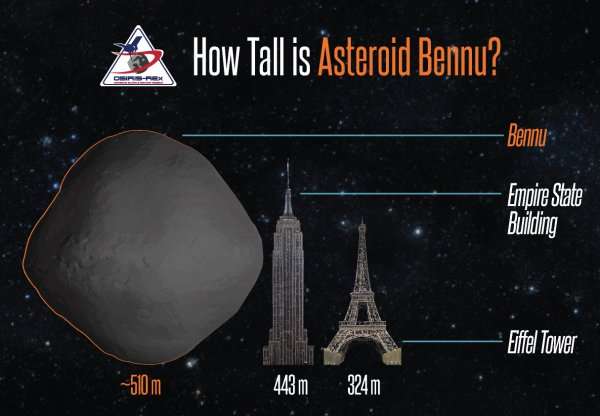Taking the measure of an asteroid

CU Boulder scientists have a front row seat today to observe a NASA spacecraft as it arrives at the asteroid Bennu, coming to within 4.5 miles of the space rock.
This close approach, followed by a flyby Dec. 4, is the first in a series of planned meet ups between the Origins, Spectral Interpretation, Resource Identification, Security-Regolith Explorer (OSIRIS-REx) and Bennu. Today's encounter will be good practice for 2020, when the spacecraft will deploy its retractable arm to grab material from the asteroid's surface and return it to Earth—the first time that a NASA mission will obtain such a sample.
Scientists from CU Boulder are playing an important role in that historic snatch-and-run. Over the next several days, a team led by Distinguished Professor Daniel Scheeres will take the first stab at calculating a simple, but critical, number: Bennu's mass.
Knowing the mass of this 1,600-foot-wide asteroid will reveal valuable information about not just Bennu, but other chunks of space debris, too, Scheeres said. That includes how they move and spin, what they're made of and how scientists might knock them aside if they're flying toward Earth.
"Once we get the first flyby and we nail the first mass, that's going to be hugely important," said Scheeres of the Ann and H.J. Smead Department of Aerospace Engineering Sciences. "Because right now, there's a lot of uncertainty. Soon, those uncertainties are going to collapse down to show us what this body is like."

Solar system leftovers
He and his colleagues are also just excited to see Bennu up close for the first time from the operations center at the University of Arizona. "It's going to be a great party—a lot of work, but a great party," Scheeres said.
The University of Arizona leads science operations for OSIRIS-REx, which was built by the Colorado-based Lockheed Martin Space. NASA's Goddard Space Flight Center in Maryland manages the overall mission.
OSIRIS-REx launched in September 2016 and has traveled more than one billion miles since, looping around the Earth's sun to rendezvous with Bennu. The asteroid has an orbit that brings it relatively close to Earth about once every six years.
This meeting will provide scientists with a rare window to look back at the beginnings of Earth's solar system, said Jay McMahon, an assistant professor in aerospace engineering at CU Boulder.
"One of the big draws for asteroids is that they're leftovers from the formation of the solar system," said McMahon, a co-investigator on the mission. "Bennu is a building block of the planets that didn't end up in a planet."
But to dive into that past, OSIRIS-REx will first need to get close enough to Bennu to snag a sample of the loose, rocky material from its surface in 2020. That's where the CU Boulder team comes in. McMahon explained that as OSIRIS-REx brushes past Bennu this time, the asteroid will exert a minute gravitational pull on the spacecraft. By precisely measuring that pull, his team can begin to map out the asteroid's gravitational field, essential information for any spaceflight operation.
"Once we have this data, we can plug it back in and that will help with planning out the trajectory for the rest of the mission," said Daniel Brack, a graduate student in aerospace engineering and a participant in the project.
Running the odds
The group's data will also put Bennu on the scale, giving scientists an estimate of its mass. Once the team knows how heavy Bennu is, OSIRIS-REx researcher Andrew French said, they can begin to guess at what it's made of on the inside—past the reach of OSIRIS-REx's arm.
"We're going to go and touch Bennu and get a sample, but that's only going to give us a look at the first couple of millimeters, or maybe centimeters, of the material on top," French said. "So you don't get a lot of insight to what it's made of underneath."
The researchers' sneak peek at Bennu could provide scientists with a wealth of information about how the asteroid formed and how its orbit might evolve over time. Researchers believe that it's possible, but extremely unlikely, that the asteroid could crash into our planet sometime between 2175-2199.
For now, this week's flyby will mark the culmination of a lot of hard work for the CU Boulder researchers.
"All of a sudden, it's here and it's really exciting," McMahon said.
Provided by University of Colorado at Boulder





















